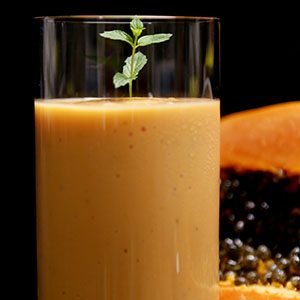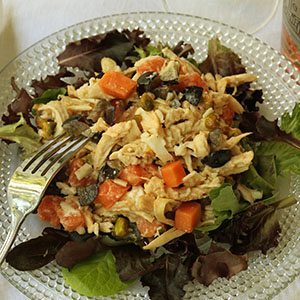Papayas were the 1980s version of the mangosteen. Back in the day, papaya was hard to find and considered exotic by most home cooks, except those living in tropical regions.
Nowadays the fruit is so common some supermarkets offer it pre-cut in grab-and-go fruit sections, which takes the guesswork out of selecting ripe specimens. If cut, look for a deep orange color flesh and black seeds that indicate ripeness and sweetness.
If uncut fruit is the only option, seek out those with mostly yellow skin. Look for unbruised, smooth skin. When papaya is gently squeezed it should be slightly soft, like a cantaloupe.
Papaya, which is super high in vitamin C and fiber, and reportedly dubbed “The Fruit of the Angels” by Christopher Columbus, will ripen after picking. When stored at room temperature, it will continue to ripen. Adding to its goodness, papaya is also relatively low in calories even when fully ripe and sweet.
If the only option is a green, unripe papaya, there is no need to stress. In some Asian cuisines, like Thai, green papaya is deliciously fixed into a savory salad taking advantage of the sour flavor that pairs so well with chilies, peanuts, and lime juice. The salad is typically served room temperature.
Hot Papaya?
Mexicans often cook papaya, a preparation that was new to me. After editing food articles for more than 20 years and teaching cooking for the last two years, some of my students think I know everything. The more I know, however, the more I realize how little I know.

Case in point, I never tasted, cooked or even heard of heating papaya. Cooking show host and celebrity chef Rick Bayless created a Sweet and Savory Caramelized Papaya with Mexican Cheese. The chef, who is based in Chicago with restaurants Frontera Grill, Topolobampo and Xoco, posted the candied papaya recipe on his website: rickbayless.com. The dish was featured on PBS’ “Mexico — One Plate at a Time.”
To candy the papaya, Bayless cooks it on a stovetop until soft, and then chars it using a blowtorch. He teams his cooked papaya with Chihuahua cheese or Queso Fresco.
After the crème brûlée craze some home cooks became comfortable with mini blow torches and stock them in their pantries. Restaurant cooks have long used the commercial torches. For the more timid culinarians, chef Bayless suggests using a broiler to brown the concoction.
Bayless’ restaurants today offer a more complex take on the dish, says Casey Cora, Bayless’ media director. Pastry chefs team candied papaya with an Edam cheese and papaya sorbet. For a wine pairing with the dessert, sommelier Jill Gubesch recommends Errazuriz’ Late Harvest Sauvignon Blanc, Casablanca Valley, Chile 2012.
With or without a sweet wine, find an easy-to-make home roasted sweet papaya recipe inspired by Bayless’s Mexican dish on page 61. In our version, the papaya is roasted in one pan without need for a blowtorch. The warm fruit can be poured over vanilla gelato, grilled pork chops, roasted chicken or a mild cheese, like Brie.
Say “Cheese”
Papaya and cheese may sound like an ill-suited marriage, but they are not. Try the cooked or raw ripened fruit next to most any delicate and salty cheeses, like a high-quality Queso Fresco. You may be surprised how well the two taste together in much the same way watermelon and mild salty cheeses pair well. The salt in the cheese amplifies the sweetness of the fruit.
In an informal tasting of ripe papaya and cheese, many cheeses went well with the fruit, even some of the stronger flavors, such as an assertive Gorgonzola and flavorful Feta.
Sweet cheeses also taste great with papaya. The fruit also blended well with Labne, a Middle Eastern yogurt cheese. Because there isn’t a lot of excess water in papaya, the fruit makes a healthful and super thick smoothie. See the recipe below.
For a savory salad, toss raw papaya chunks into a chicken salad with a young Gouda. If you really want a retro look, scoop the salad back into a hollowed out papaya shell. This dish was a big hit in restaurants back in the ‘80s, but many young folks may find it new and refreshing.
Best of all, and unlike some tropical fruit that are now considered exotic, like mangosteen, rambutan and jackfruit, papaya requires no primer in order to prepare. Just peel, scoop out the seeds and eat.
Papaya-Labne Shake
Serve this shake for breakfast or along with roasted lamb or grilled hot dogs. It’s slightly sweet, but can be adjusted to taste. It holds for a couple days.
Labne, also known as yogurt cheese, is very thick Greek-style yogurt sold in many Middle East grocery stores. If unavailable, strain regular yogurt through cheesecloth until it is thick enough for a spoon to stand in it.

Makes 6 cups
Ingredients:
6 cups Powerful Harvest Papaya by New Limeco, peeled, seeded and chopped
2/3 cup labne
½ cup honey
1/3 cup fresh lime juice
12 ice cubes
Small handful fresh basil or mint leaves, about 16, plus a few leaves to garnish
In a strong, professional-style blender, combine all the ingredients, except herb leaves for garnishing, and puree until smooth, about 30 seconds. Taste and add more honey, if desired.
Garnish with remaining herbs. Serve cold.
Papaya Pesto With Burrata
Serve as a light snack to accompany cocktails. Try it with grilled pizza dough lightly drizzled with olive oil or with toasted sliced ciabatta.

Servings: 4
Ingredients:
1/3 cup pine nuts
1 cup packed basil leaves, stems removed
½ tsp white balsamic vinegar or white wine vinegar
3 Tbsp olive oil
Salt and pepper
1 cup ripe Powerful Harvest Papaya by New Limeco, cut into ¼-inch dice
¼ cup grape tomatoes, cut into ¼-inch dice
1 lb Burrata or Mozzarella
Heat oven to 350°F. Toast pine nuts in preheated oven until golden brown, about 7 minutes. Cool nuts to room temperature.
In a small food processor put basil leaves, vinegar and all but a tablespoon of the pine nuts. Then grind until mixture is smooth. With the processor running, add olive oil in a thin stream. Season pesto to taste with salt and pepper.
In a bowl, gently fold the papaya and tomatoes with the pesto. Season with salt and pepper to taste.
Pour the papaya pesto over the cheese. Sprinkle with remaining pine nuts.
All Chicken And Papaya Salad
Rotisserie chicken works particularly well for this salad. It can be prepared a day or two ahead.

Servings: 2
Ingredients:
2 cups cooked chicken meat, shredded into bite-size pieces
11/3 cups Powerful Harvest Papaya by New Limeco, peeled, halved, seeded and cut into bite-size pieces
2/3 cup young Gouda, coarsely shredded
3 Tbsp mayonnaise
½ cup shelled pistachio nuts, coarsely chopped
½ cup dark grapes, quartered
Salt
1 handful baby lettuce greens
In a large bowl place the cooked chicken, papaya, Gouda, mayonnaise, pistachios, grapes and just a pinch of salt. Using a spatula, fold all of the ingredients together until they are just barely combined.
Taste the salad and season it with additional salt if needed and until it tastes delicious. Serve at cool or room temperature on chilled plates and a bed of crispy lettuce.
Roasted Papaya
This candied papaya makes good use of extra papaya that is ripe. Once roasted with honey, it will last for at least a week in the refrigerator, if you don’t eat it all in one sitting. The cooked fruit is great over Brie, cold, hot or room temperature. The versatile mixture is also fine with other slightly salty mild cheeses like a young Chèvre. It was adapted from a Mexican recipe from Chef Rick Bayless. For a sweet take, pour the fruit over vanilla gelato or bake it into an almond flour cake or frangipane-style tart.

Servings: 4
Ingredients:
1½ lbs ripe Powerful Harvest Papaya by New Limeco, peeled, seeded and sliced into matchstick-size pieces
3 Tbsp honey
1½ Tbsp light brown sugar
1 Tbsp peanut or other mild-flavored oil
1/8 tsp salt
¼ tsp ground cinnamon
Preheat oven to 400°F. Line a large rimmed cooking sheet pan with parchment paper.
Gently toss the papaya, honey, sugar, oil, salt and cinnamon together on the pan and spread evenly getting into the corners in a single layer. Do not overcrowd the pan, which means you can see some of the parchment paper.
Roast fruit in preheated oven with convection on, if available, until edges are lightly charred, browned and fruit is cooked, about 20 minutes.



